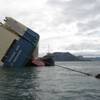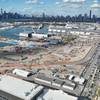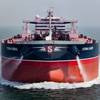Key Salvage Issues for 2013 – and Beyond…
This is a good time to look aft and reflect on the accomplishments achieved in 2012, as well as to the distant horizon to see what challenges loom in 2013, and beyond. It is fair to say that the Coast Guard and salvage industry have come a long way in the last few years with implementation of a salvage and firefighting final rule; first published in December 2008, delayed until February 22, 2011, to provide for harmonization with the changes to the vessel and facility amendments for response plans.
With the interpretation of this final rule largely having been worked out, this is nevertheless no time to rest. There are many other issues in other areas that still need a lot of work. Specifically, three key issues remain for the government and industry to prioritize for 2013. They include implementation of the nontank vessel response plan (NTVRP) final rule, places of refuge, and responder immunity.
Non-tank Vessel Response Plans
The industry has been waiting for years for the Coast Guard to finally implement regulations requiring non-tank vessels to meet response plan requirements. The Coast Guard and Maritime Transportation Act of 2004 (Pub. L. 108-293) contained a provision requiring owners and operators of all non-tank vessels of 400 gross tons or greater—as measured under the International Tonnage Convention (ITC)—to prepare and submit NTVRPs to the Coast Guard by August 8, 2005. On February 4, 2005, the Coast Guard issued Navigation and Vessel Inspection Circular (NVIC) 01-05, which was amended by NVIC 01-05, CH-1, dated January 13, 2006, in order to provide interim guidance for the development and review of NTVRPs.
Regulations were not issued over the next several years, but the Coast Guard issued a notice on June 23, 2008 to inform U.S. and foreign-flag non-tank vessel owners and operators that, effective August 22, 2008, it would begin enforcing the requirement to prepare and submit an NTVRP for certain non-tank vessels based on the requirements contained in the law. In the absence of such regulations, the Coast Guard has been enforcing NTVRP compliance for such vessels pursuant to the Ports and Waterways Safety Act. Finally, the Coast Guard issued a notice of proposed rulemaking (NPRM) on August 31, 2009. In the meantime, industry has waited patiently for the final rule to make its way through the Coast Guard and Department of Homeland Security review process. It now appears that the rule will finally be published in the near future. The Office of Management and Budget (OMB) commenced review of the final rule on March 9, 2013. OMB review of a rule generally takes 90 days. Hence, it can be expected that the final rule will be published in the Federal Register in June 2013 subject to OMB delaying publication or taking other action. This will be an important milestone in formalizing the response plan regime for the large number of non-tank vessels operating in U.S. waters.
Places of Refuge
Simply described, a place of refuge is an extension of the broadly accepted principle of force majeure at sea. Under principles of force majeure, those found at peril at sea should be assisted by any person to remove them from such peril. Similarly, in cases in which the ship itself and the ship’s cargo are at peril, the obligation arises for countries to provide a place of refuge for a vessel to minimize additional damage and to make necessary repairs as quickly as practicable in order for the vessel to depart.
In the choppy wake of controversial incidents at sea involving the M/V Erica (1999), the M/V Castor (2000), and the M/V Prestige (2002) involving tank ship structural failures at sea, the International Maritime Organization (IMO) adopted a resolution entitled “Guidelines on Places of Refuge for Ships in Need of Assistance” on December 5, 2003.
The IMO resolution provides guidelines, not only for masters or salvors in need of places of refuge, but also guidelines for actions expected of port States. The resolution rightly recognizes the authority of the coastal State to exercise its authority in such cases taking into account the threat presented by the ship based on a number of factors. Importantly, when a master requests permission to enter a port for refuge, although there is no obligation for a port State to grant it, under the resolution the port State is urged to consider and balance all the factors and risks in making a determination as to whether to grant refuge. The Coast Guard issued its policy on places of refuge on July 17, 2007 in the form of Commandant Instruction 16541.9. This policy essentially adopts the Incident Command System as the central process mechanism to address refuge cases should they arise. In such cases the local Coast Guard Captain of the Port (COTP) is responsible for granting or denying claims of force majeure and requests for safe refuge. This is similar to the Unified Command concept used for oil spill response cases in which all stakeholders participate (owner/operators, state and local representatives, salvors, oil spill removal organizations (OSROs)). This is a sound mechanism because it is the one that not only the government but also industry itself has used successfully over the years in pollution incidents. Of note, the recent incident involving the grounding of the 28,000-ton drill ship Kulluk in January 2013 after breaking tow lines during stormy weather demonstrates that the Unified Command system also works well for these types of incidents. The Unified Command was established when the tow could not quickly be re-attached. Ultimately, the Unified Command made a decision to allow the Kulluk to be grounded off of Kodiak Island. The Kulluk incident provides a good example of how things can and should work in such cases. That said, and in order to ensure future successes in this area, it is incumbent on industry and the Coast Guard to identify potential places of safe refuge and to conduct place of refuge exercises and drills on a routine basis around the country in the various COTP areas.
In addition to the issues described above, the issue of responder immunity still looms large in the porthole as a major point of contention. This combined with a raft of other pending environmental and safety regulatory efforts will keep both the United States Coast Guard and the industry that it oversees, extremely busy, well into 2013 and beyond. Mutual cooperation and communication will be a key ingredient to all of this as it unfolds. Much of it remains a work in progress.
Jonathan Waldron is Chairman of the ASA Legal Committee. He concentrates his practice in maritime, international, and environmental law, including maritime security. Mr. Waldron is a visiting professor at the Massachusetts Maritime Academy where he teaches on legal issues related to pollution response and spill management teams. He is a member of the Maritime Law Association and frequently speaks and writes on maritime issues.
(As published in the April 2013 edition of Marine News - www.marinelink.com)







